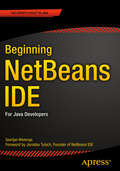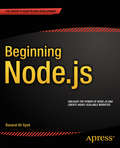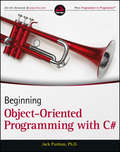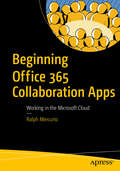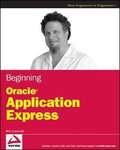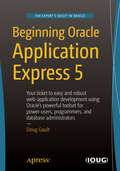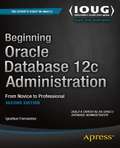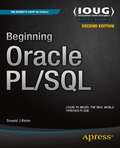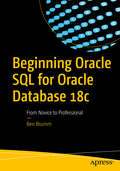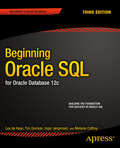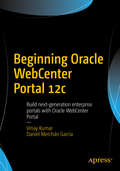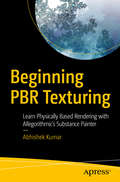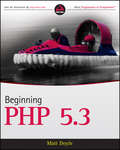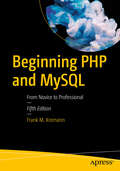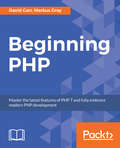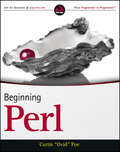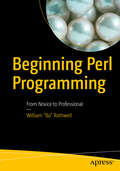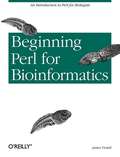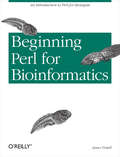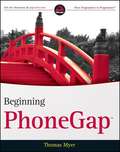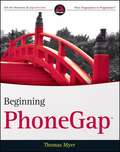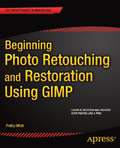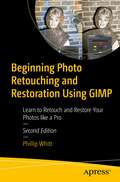- Table View
- List View
Beginning NetBeans IDE: For Java Developers
by Geertjan WielengaBeginning NetBeans IDE is your authoritative guide for getting started learning and using the free and open source NetBeans IDE. Written by Geertjan Wielenga, who has worked on the NetBeans Team since 2004, it shows you what the IDE is all about and how to use it with real-world case studies built from the ground up as you learn all about the IDE. In this book, you get a tour of the various, essential, and key NetBeans features, including a range of wizards and plug-ins. Then, you start building a more complex Java EE-based application using Maven with the NetBeans IDE. And, you learn how to improve that application by exploring the NetBeans refactoring, testing, debugging, and profiling tools. After reading and using this guide, you'll come away with a working case study and many insights into how to understand and optimally make use of NetBeans IDE. What you'll learn What is NetBeans and how to use it How to install and set up your NetBeans IDE and environment How to write your first Java application using NetBeans How to explore the key NetBeans wizards and plug-ins How to build a complex Java EE-based application using Maven with NetBeans How to improve applications by refactoring, testing, debugging, and profiling Who this book is for This book is for those who are new to NetBeans who may have prior Java coding experience. Table of Contents 1. Installing and Setting Up 2. Getting Started 3. Java Editor 4. Using Wizards and Plugins 5. Putting the Pieces Together 6. Analysis and Refactoring 7. Testing and Code Quality 8. Debugging 9. Profiling and Tuning 10. Versioning
Beginning Node.js
by Basarat Ali SyedBeginning Node. js is your step-by-step guide to learning all the aspects of creating maintainable Node. js applications. You will see how Node. js is focused on creating high-performing, highly-scalable websites, and how easy it is to get started. Many front-end devs regularly work with HTML, CSS, PHP, even WordPress, but haven't yet got started with Node. js. This book explains everything for you from a beginner level, enabling you to start using Node. js in your projects right away. Using this book you will learn important Node. js concepts for server-side programming. You will begin with an easy-to-follow pure JavaScript primer, which you can skip if you're confident of your JS skills. You'll then delve into Node. js concepts such as streams and events, and the technology involved in building full-stack Node. js applications. You'll also learn how to test your Node. js code, and deploy your Node. js applications on the internet. Node. js is a great and simple platform to work with. It is lightweight, easy to deploy and manage. You will see how using Node. js can be a fun and rewarding experience - start today with Beginning Node. js. What you'll learn * Learn how JavaScript can help you be highly productive as a full-stack developer * How to set up an end to end Node. js development environment * Learn how to create reusable and maintainable Node. js modules * Patterns for sharing code between the server and the client * Create Node. js restful web services and websites * Store and retrieve your data using Document Databases * How to test your Node. js applications * How to deploy your applications on the internet Who this book is for Beginning Node. js is great for front-end developers looking to use Node. js in their websites. If you understand the basics of programming this book will teach you how you can leverage JavaScript to create full stack web-apps using Node. js. Node. js allows you to write code that runs both on the client and server. This allows you to reuse more code and deliver applications faster. From this book you will learn how to write maintainable server-side JavaScript using Node. js, how to test your code and deploy it on the internet. Table of Contents Chapter 1: Setting up for Node. js Development Chapter 2: Understanding Node. js Chapter 3: Core Node. js Chapter 4: Node. js Packages Chapter 5: Events and Streams Chapter 6: Getting Started with HTTP Chapter 7: Introducing Express Chapter 8: Persisting Data Chapter 9: Front-End Basics Chapter 10: Simplifying Callbacks Chapter 11: Debugging Chapter 12: Testing Chapter 13: Deployment and Scalability
Beginning Object-Oriented Programming with C#
by Jack PurdumThe ideal beginner's guide to C# and object-oriented programmingWrox beginners' guides have the perfect formula for getting programming newcomers up and running. This one introduces beginners to object-oriented programming using C# to demonstrate all of the core constructs of this programming framework. Using real-world situations, you'll discover how to create, test, and deliver your programs and how to work with classes, arrays, collections, and all the elements of object-oriented programming.Covers exactly what beginners, even those with no prior programming experience, need to know to understand object-oriented programming and start writing programs in C# Explains the advantages and disadvantages of C#, and tips for understanding C# syntax Explores properties, encapsulation, and classes; value data types; operands and operators; errors and debugging; variables; and reference types Shows how to use statement repetition and program loops, understand arrays and collections, and write your own classes Also covers inheritance and polymorphismBeginning Object-Oriented Programming with C# uses the tried-and-true Wrox formula for making this popular programming method easy to learn.
Beginning Office 365 Collaboration Apps: Working in the Microsoft Cloud
by Ralph MercurioStart making the most of the latest collaboration tools in Office 365—including SharePoint, OneDrive, Office 365 Groups, Office, Teams, Yammer, Planner, Stream, Forms, and Flow—and integrate them into your team’s projects to boost productivity, engagement, innovation, and enjoyment at work. This book walks you through the features, teaching you how to choose the right tools for your situation.While technologies for collaboration are more advanced than ever before, there also are more of them. Beginning Office 365 Collaboration Apps will help you make sense of what is available and how it can help you and your team be more productive.What You'll LearnKnow the collaboration features available across Office 365, and how to choose the ones that are right for you and your colleagues in any given situationUnderstand the software-as-a-service (SaaS) model and how it enables users to be more productive and effectiveDiscover how multi-device usability and real-time cloud synchronization can help your team collaborate any time, anywhere, across the appsFind out how Planner can help you manage projects and tasks, even without a project managerExplore Microsoft Flow to connect applications and services and create code-less workflowsWho This Book is ForOffice 365 business users with a limited technical background. You should be familiar with the Microsoft Office suite products such as Word and Outlook, and work in a team environment.
Beginning OpenVPN 2.0.9
by Markus Feilner Norbert GrafThis book is an easy introduction to OpenVPN. While providing only necessary theoretical background, it takes a practical approach, presenting plenty of examples. It is written in a friendly style making this complex topic easy and a joy to read. It first covers basic VPN concepts, then moves to introduce basic OpenVPN configurations, before covering advanced uses of OpenVPN. This book is for both experienced and new OpenVPN users. If you are interested in security and privacy in the internet, or want to have your notebook or mobile phone connected safely to the internet, the server in your company, or at home, you will find this book useful. It presumes basic knowledge of Linux, but no knowledge of VPNs is required.
Beginning Oracle Application Express
by Rick GreenwaldThis book shows you how to master Application Express to build effective web-based Oracle database applications. The author provides hands-on, step-by-step guidance on the complete development process, through creating, customizing, and extending the application. In addition to presenting how to build a simple application, this guide also details reporting and charting, themes and templates, and security. Additionally, it demonstrates how to use packaged applications and how to work with multiple applications. Data migration and integration with the Oracle environment is also discussed.
Beginning Oracle Application Express 5
by Doug GaultWhether you're new to Oracle or an old hand who's yet to test the waters of APEX, Beginning Oracle Application Express 5 introduces the processes and best practices you'll need to become proficient with APEX. The book shows off the programming environment, the utilities and tools available, and then continues by walking through the process of building a working system from the ground up. All code is documented and explained so that those new to the languages will not be lost. After reading this book, power users and programmers alike can quickly put together robust and scalable applications for use by one person, by a department, by an entire company. Beginning Oracle Application Express 5 introduces version 5 of the popular and productive Oracle Application Express development platform. Called APEX for short, the platform enables rapid and easy development of web-based applications that make full use of Oracle Database. The release of APEX 5 brings major new changes to the page builder, an enhanced universal theme, better RESTful web services support, enhanced application packaging, and the many redesigned wizards give a new and fresh feel to the user interface. Covers brand-new functionality in APEX 5 Provides fully documented and explained example code Guides you through creating a working and fully deployable application What you'll learn Design, code, and troubleshoot APEX applications Create forms and reports, and generate charts using Flash and HTML 5 Take advantage of improved, RESTful web services support Create intuitive navigation that inspires confidence among users Secure your applications from outside attack Deploy applications for one, a dozen, or hundreds of users Choose between desktop and mobile user interfaces for deployed applications Who this book is for Beginning Oracle Application Express 5 is for programmers and power users wanting to create rich, data-centric applications that are web-based, and that rest on Oracle's industry-leading database technology. Table of Contents 1. An Introduction to APEX 2. A Developer's Overview 3. Identifying the Problem and Designing the Solution 4. SQL Workshop 5. Application and Navigational Components 6. Forms & Reports--The Basics 7. Forms & Reports--Advanced 8. Programmatic Elements 9. Security 10. Application Deployment 11. Understanding Websheets 12. A WebSheets Example 13. Extended Developer Tools 14. Managing Workspaces 15. Team Development 16. Dynamic Actions 17. Appendix A
Beginning Oracle Database 12c Administration: From Novice to Professional
by Ignatius FernandezBeginning Oracle Database 12c Administration is your entry point into a successful and satisfying career as an Oracle Database Administrator. The chapters of this book are logically organized into four parts closely tracking the way your database administration career will naturally evolve. Part 1 "Database Concepts" gives necessary background in relational database theory and Oracle Database concepts, Part 2 "Database Implementation" teaches how to implement an Oracle database correctly, Part 3 "Database Support" exposes you to the daily routine of a database administrator, and Part 4 "Database Tuning" introduces the fine art of performance tuning. Beginning Oracle Database 12c Administration provides information that you won't find in other books on Oracle Database. You'll discover not only technical information, but also guidance on work practices that are as vital to your success as are your technical skills. The author's favorite chapter is "The Big Picture and the Ten Deliverables. " (It is the editor's favorite chapter too!) If you take the lessons in that chapter to heart, you can quickly become a much better Oracle database administrator than you ever thought possible. You will grasp the key aspects of theory behind relational database management systems and learn how to: * Install and configure an Oracle database, and ensure that it's properly licensed; * Execute common management tasks in a Linux environment; * Defend against data loss by implementing sound backup and recovery practices; and * Improve database and query performance. What you'll learn Execute common management tasks in a Linux environment. Take advantage of pluggable database features for cloud and consolidation. Install and configure an Oracle database, and see that it's properly licensed. Defend against data loss by implementing sound backup and recovery practices. Properly size a database, and create indexes to improve its query performance. Grasp the key aspects of theory behind relational database management systems. Who this book is for Beginning Oracle Database 12c Administration is the perfect book for those wanting to jumpstart a career in database administration. If you're making the move into that role, or if the role has been thrust upon you by circumstances, you can hardly do better than to have author Iggy Fernandez at your side as you learn the ropes and lay down the foundation of your future success. Table of Contents Part I: Database Concepts 1. Relational Database Management Systems 2. SQL and PL/SQL 3. Oracle Architecture Part II: Database Implementation 4. Planning 5. Software Installation 6. Database Creation 7. Physical Database Design 8. User Management and Data Loading Part III: Database Support 9. Taking Control 10. Monitoring 11. Fixing Problems 12. Backups 13. Recovery 14. Database Maintenance 15. The Big Picture and the Ten Deliverables Part IV: Database Tuning 16. Instance Tuning 17. SQL Tuning
Beginning Oracle PL/SQL (Expert's Voice In Oracle Ser.)
by Donald J. BalesGet started with PL/SQL, the built-in language that every Oracle developer and database administrator must know, in Beginning PL/SQL, a fast-paced and example-filled tutorial. Learn from author Don Bales extensive experience to discover the most commonly used aspects of PL/SQL, without wasting time with obscure and obsolete features. Bales takes his 20+ years of experience and a wealth of statistics he's gathered on PL/SQL usage over those years and applies the 80/20 rule: cover what's most needed and used by PL/SQL professionals and avoid what's not necessary! The result is a book that covers all the key features of PL/SQL without wasting your time discussing esoteric and obsolete parts of the language. Learn what really matters, so that you can get to work feeling confident with what you know about PL/SQL. Discover the 20% of PL/SQL that gives you 80% of the bang! Key topics covered include variables and datatypes, executing statements, working with cursors, real-world objects, debugging, testing, and more. Learn how to write production-level, object-oriented PL/SQL. You'll explore relational PL/SQL, but unlike most other books on the subject, this one emphasizes the use of PL/SQLs object-oriented features as well. Work through real examples of using of PL/SQL. You'll learn PL/SQL by applying it to real-world business problems, not by heavy theory. What you'll learn How important SQL is in PL/SQL How to use PL/SQL in both a relational and object-relational setting How to create maintainable, modular, and reusable PL/SQL program units The importance of testing as you go, and of building a permanent test plan for each module The importance of building debugging capabilities into your code and building a permanent debug facility for each module The importance of documenting as you go, and in the process building a permanent documentation set for your reusable modules How to apply modular PL/SQL to solve real-world problems Who this book is for Anyone who wants to learn how to create stored procedures against an Oracle database using PL/SQL. Programmers developing applications to be deployed against an Oracle database will need PL/SQL to take full advantage of the power Oracle has to offer. Database administrators who wish to implement functionality exposed only via PL/SQL package interfaces will also find this book useful.
Beginning Oracle SQL for Oracle Database 18c: From Novice to Professional
by Ben BrummStart developing with Oracle SQL. This book is a one-stop introduction to everything you need to know about getting started developing an Oracle Database. You'll learn about foundational concepts, setting up a simple schema, adding data, reading data from the database, and making changes. No experience with databases is required to get started. Examples in the book are built around Oracle Live SQL, a freely available, online sandbox for practicing and experimenting with SQL statements, and Oracle Express Edition, a free version of Oracle Database that is available for download.A marquee feature of Beginning Oracle SQL for Oracle Database 18c is the small chapter size. Content is divided into easily digestible chunks that can be read and practiced in very short intervals of time, making this the ideal book for a busy professional to learn from. Even just a 15-20 minute block of free time can be put to good use.Author Ben Brumm begins by helping you understand what a database is, and getting you set up with a sandbox in which to practice the SQL that you are learning. From there, easily digestible chapters cover, point-by-point, the different aspects of writing queries to get data out of a database. You’ll also learn about creating tables and getting data into the database. Crucial topics such as working with nulls and writing analytic queries are given the attention they deserve, helping you to avoid pitfalls when writing queries for production use.What You'll LearnCreate, update, and delete tables in an Oracle databaseAdd, update, delete data from those database tablesQuery and view data stored in your databaseManipulate and transform data using in-built database functions and featuresCorrectly choose when to use Oracle-specific syntax and featuresWho This Book Is ForThose new to Oracle who are planning to develop software using Oracle as the back-end data store. The book is also for those who are getting started in software development and realize they need to learn some kind of database language. Those who are learning software development on the side of their normal job, or learning it as a college student, who are ready to learn what a database is and how to use it also will find this book useful.
Beginning Oracle SQL: For Oracle Database 12c
by Lex De Haan Tim Gorman Inger Jørgensen Melanie CaffreyBeginning Oracle SQL is your introduction to the interactive query tools and specific dialect of SQL used with Oracle Database. These tools include SQL*Plus and SQL Developer. SQL*Plus is the one tool any Oracle developer or database administrator can always count on, and it is widely used in creating scripts to automate routine tasks. SQL Developer is a powerful, graphical environment for developing and debugging queries. Oracle's is possibly the most valuable dialect of SQLafrom a career standpoint. Oracle's database engine is widely used in corporate environments worldwide. It is also found in many government applications. Oracle SQL implements many features not found in competing products. No developer or DBA working with Oracle can afford to be without knowledge of these features and how they work, because of the performance and expressiveness they bring to the table. Written in an easygoing and example-based style, Beginning Oracle SQL is the book that will get you started down the path to successfully writing SQL statements and getting results from Oracle Database. Takes an example-based approach, with clear and authoritative explanations Introduces both SQL and the query tools used to execute SQL statements Shows how to create tables, populate them with data, and then query that data to generate business results"
Beginning Oracle WebCenter Portal 12c: Build next-generation enterprise portals with Oracle WebCenter Portal
by Vinay Kumar Daniel Merchán GarcíaDevelop enterprise portals with Oracle WebCenter Portal 12c software and enrich those applications with social computing services, including discussions, documents, blogs, wikis, tags, and links. This book covers all functionalities and aspects from a developer, architect, and administrator point of view. Enterprise portal technology is used for creating intranet and extranet portals which enhance collaboration within a company. The book is intended to complete and fill in the gaps of the official documentation from an administrator and developer perspective. Beginning Oracle WebCenter Portal 12c provides an overview of the architecture behind Oracle WebCenter Suite and the Oracle Fusion Middleware platform. Sample code written in Java is included along with best practices developed from the authors' experience of using Oracle WebCenter Portal for building enterprise portals. What you will learn: Enterprise Portal and Oracle WebCenter Portal concepts Basic administrator knowledge Basic developer knowledge Overview of the tools and services offered by Oracle WebCenter Portal How to develop Portal Assets using JDeveloper IDE How to develop new components(Portlets JSR-286 and ADF Task Flows) using JDeveloper IDE REST API integration with Portal Enterprise content management with Portal Who this book is for: Developers, architects, project managers and portal administrators in the Oracle Fusion Middleware (FMW) area. IT professionals working in FMW or WebLogic stack can also make use of this book.
Beginning PBR Texturing: Learn Physically Based Rendering with Allegorithmic’s Substance Painter
by Abhishek KumarDelve into the concepts of physically based rendering (PBR) using Allegorithmic’s Substance Painter. This book covers the integration of PBR textures with various 3D modeling and rendering packages as well as with the Unreal Engine 4 game engine.Beginning PBR Texturing covers all aspects of the software and guides you in implementing its incredible possibilities, including using materials, masks, and baking. Integration with both internal and popular external rendering engines is covered.This book teaches you the skills you need to use the texturing tool that is recognized by studios worldwide. You will know tips and tricks to implement the pipeline and speed up your workflow.What You Will LearnKnow the fundamentals of PBR-based texturing from the ground upCreate production-ready textured models from scratchIntegrate PBR textures with standard 3D modeling and rendering applicationsCreate portfolio-ready renders using offline renderersWho This Book Is For Beginners in the fields of 3D animation, computer graphics, and game technology
Beginning PHP 5.3
by Matt DoyleThis book is intended for anyone starting out with PHP programming. If you've previously worked in another programming language such as Java, C#, or Perl, you'll probably pick up the concepts in the earlier chapters quickly; however, the book assumes no prior experience of programming or of building Web applications. That said, because PHP is primarily a Web technology, it will help if you have at least some knowledge of other Web technologies, particularly HTML and CSS. Many Web applications make use of a database to store data, and this book contains three chapters on working with MySQL databases. Once again, if you're already familiar with databases in general -- and MySQL in particular -- you'll be able to fly through these chapters. However, even if you've never touched a database before in your life, you should still be able to pick up a working knowledge by reading through these chapters.
Beginning PHP and MySQL: From Novice to Professional
by Frank M. KromannGet started with PHP and MySQL programming: no experience necessary. This fifth edition of a classic best-seller includes detailed instructions for configuring the ultimate PHP 7 and MySQL development environment on all major platforms, complete coverage of the latest additions and improvements to the PHP language, and thorough introductions to MySQL’s most relied-upon features. You'll not only receive extensive introductions to the core features of PHP, MySQL, and related tools, but you'll also learn how to effectively integrate them in order to build robust data-driven applications. Author Frank M. Kromann draws upon more than 20 years of experience working with these technologies to pack this book with practical examples and insight into the real-world challenges faced by developers. Accordingly, you will repeatedly return to this book as both a valuable instructional tool and reference guide. What You Will LearnInstall PHP, MySQL, and several popular web serversGet started with PHP, including using its string-handling, networking, forms-processing, and object-oriented featuresGain skills in MySQL’s fundamental features, including supported data types, database management syntax, triggers, views, stored routine syntax, and import/export capabilitiesWork with hundreds of examples demonstrating countless facets of PHP and MySQL integrationWho This Book Is ForAnyone who wants to get started using PHP to write dynamic web applications.
Beginning PHP: Master the latest features of PHP 7 and fully embrace modern PHP development
by David Carr Markus GrayLearn all the fundamentals of PHP with a book that blends theory with practice to build up the skills you need for modern web development.Key FeaturesBrush up on basic PHP 7 syntax and work with variables, data types, arrays, and loops Master advanced concepts like building your own frameworks and creating your own applicationsApply your newly learned PHP skills to a variety of real-life business scenariosBook DescriptionPHP is the preferred server-side scripting language for tech giants such as Facebook, Wikipedia, and Tumblr despite full-stack JavaScript gaining popularity with upcoming developers. This is because PHP performs better when dealing with heavy computations on the back end. In this book, you’ll learn everything you need to get up and running with the latest version of PHP, including package management with tools such as composer, secure database operations, and a whole host of other best practices that will help you stay a step ahead of traditional programmers.What you will learnUnderstand the fundamentals of PHP and work with classes and inheritanceLearn about database operations and package management with composerTackle common security concerns and pitfalls using authentication and validationBuild effective PHP applications and frameworks for your business needsWho this book is forIf you’re already familiar with another programming language and want to learn about the fundamentals of PHP programming, you’ll find the flow of this book to be an ideal fit. Having a prior understanding of HTML, MySQL, CSS, and JavaScript will be beneficial, but is not mandatory.
Beginning Perl
by Curtis PoeEverything beginners need to start programming with PerlPerl is the ever-popular, flexible, open source programming language that has been called the programmers' Swiss army knife. This book introduces Perl to both new programmers and experienced ones who are looking to learn a new language. In the tradition of the popular Wrox Beginning guides, it presents step-by-step guidance in getting started, a host of try-it-out exercises, real-world examples, and everything necessary for a Perl novice to start programming with confidence.Introduces Perl to both new programmers and experienced ones who want to learn a new language Provides a host of real-world applications for today's environments so readers can get started immediately Covers the new features of Perl but fully applicable to previous editions Beginning Perl provides the information and instruction you need to confidently get started with Perl.For Instructors: Classroom and training support material are available for this book.
Beginning Perl Programming: From Novice to Professional
by William "Bo" RothwellGet started with Perl 5 and learn the important core concepts of Perl programming, such as variables, flow control, expressions, and I/O. Additionally, this book covers pattern matching and shows that Perl is extremely flexible and powerful, and that it isn’t afraid of the cloud. After reading and using this book, you'll be able to start writing your own powerful scripts to solve many web and programming problems. This is a book for those of us who believed that we didn’t need to learn Perl, and now we know it is more ubiquitous than ever. You’ll see that Perl has evolved into a multipurpose, multiplatform language present absolutely everywhere: heavy-duty web applications, the cloud, systems administration, natural language processing, and financial engineering. This book provides valuable insight into Perl’s role regarding all of these tasks and more giving you a great start in your Perl programming adventure.What You Will LearnPerform operations on scalar valuesUse scalar, array, and associative array variablesWork with flow control statements such as if, unless, while, until, for, and foreachRead and write directly to files with file handles Use conditional expressions such as numeric and string comparison, regular expressions, file testing, and Perl statementsFormat output with format statements Search for and replace sub-strings within a string using regular expressionsMaster Perl utilities such as split, join, index and moreControl the file system and processes from within a Perl scriptBuild functions for tasks including handling the scope of variablesImport existing modules into your Perl scriptWho This Book Is ForThose who are new to Perl.
Beginning Perl for Bioinformatics
by James TisdallWith its highly developed capacity to detect patterns in data, Perl has become one of the most popular languages for biological data analysis. But if you're a biologist with little or no programming experience, starting out in Perl can be a challenge. Many biologists have a difficult time learning how to apply the language to bioinformatics. The most popular Perl programming books are often too theoretical and too focused on computer science for a non-programming biologist who needs to solve very specific problems. Beginning Perl for Bioinformatics is designed to get you quickly over the Perl language barrier by approaching programming as an important new laboratory skill, revealing Perl programs and techniques that are immediately useful in the lab. Each chapter focuses on solving a particular bioinformatics problem or class of problems, starting with the simplest and increasing in complexity as the book progresses. Each chapter includes programming exercises and teaches bioinformatics by showing and modifying programs that deal with various kinds of practical biological problems. By the end of the book you'll have a solid understanding of Perl basics, a collection of programs for such tasks as parsing BLAST and GenBank, and the skills to take on more advanced bioinformatics programming. Some of the later chapters focus in greater detail on specific bioinformatics topics. This book is suitable for use as a classroom textbook, for self-study, and as a reference. The book covers: Programming basics and working with DNA sequences and strings Debugging your code Simulating gene mutations using random number generators Regular expressions and finding motifs in data Arrays, hashes, and relational databases Regular expressions and restriction maps Using Perl to parse PDB records, annotations in GenBank, and BLAST output
Beginning Perl for Bioinformatics
by James TisdallMajor advances like the Human Genome Project show that programming is becoming as central to the biological sciences as it has been to physics or astronomy. As the field of bioinformatics picks up speed, biologists are more and more eager to add programming ability to their laboratory toolkits, and Perl leads the field as the language of choice for biological data analysis. Beginning Perl for Bioinformatics is a practical introduction to biological programming using Perl, the most popular language for bioinformatic analysis. Perl is strong in precisely what is needed to analyze biological data: string handling, text processing, networking, ability to control other programs, and rapid prototyping. Using this book as a springboard, biologists with no previous programming skills will be able to get up to speed quickly and embark on successful programming projects.
Beginning Perl for Bioinformatics: An Introduction to Perl for Biologists
by James TisdallWith its highly developed capacity to detect patterns in data, Perl has become one of the most popular languages for biological data analysis. But if you're a biologist with little or no programming experience, starting out in Perl can be a challenge. Many biologists have a difficult time learning how to apply the language to bioinformatics. The most popular Perl programming books are often too theoretical and too focused on computer science for a non-programming biologist who needs to solve very specific problems.Beginning Perl for Bioinformatics is designed to get you quickly over the Perl language barrier by approaching programming as an important new laboratory skill, revealing Perl programs and techniques that are immediately useful in the lab. Each chapter focuses on solving a particular bioinformatics problem or class of problems, starting with the simplest and increasing in complexity as the book progresses. Each chapter includes programming exercises and teaches bioinformatics by showing and modifying programs that deal with various kinds of practical biological problems. By the end of the book you'll have a solid understanding of Perl basics, a collection of programs for such tasks as parsing BLAST and GenBank, and the skills to take on more advanced bioinformatics programming. Some of the later chapters focus in greater detail on specific bioinformatics topics. This book is suitable for use as a classroom textbook, for self-study, and as a reference.The book covers:Programming basics and working with DNA sequences and strings Debugging your codeSimulating gene mutations using random number generatorsRegular expressions and finding motifs in dataArrays, hashes, and relational databasesRegular expressions and restriction mapsUsing Perl to parse PDB records, annotations in GenBank, and BLAST output
Beginning PhoneGap
by Thomas MyerIn order for Web developers to create mobile applications, they need to learn new programming languages, which keeps many of them out of the mobile space. PhoneGap comes to the rescue!! It lets web developers mobile applications in languages they already know. In addition, PhoneGap allows for cross-platform development, so they can develop apps for iPhone, Android, and Blackberry! Beginning PhoneGap walks the reader through installing the development software, cover the basics of each of the functional units, and then introduce the reader to various projects they can build with the framework. It features: Using PhoneGap with iPhone, Android, Blackberry Using HTML, CSS, and Javascript Using features Accelerameter, Compass Media, Storage and Files, Camera, Contacts, Geolocation Using HTML, CSS, and Javascript, languages familiar to most web developers, chapters build on each other to create a larger app, so by the end readers can have mobile apps up and running.
Beginning PhoneGap
by Thomas MyerCreate cross-platform mobile apps without having to learn a new language!PhoneGap is an open source solution, ideal for web developers wanting to build cross-platform mobile apps without having to learn a new language. Using HTML, CSS, and Javascript, PhoneGap allows you to jump into the mobile world and develop apps for iPhone, Android, and the BlackBerry.Walks you through installing the development software Covers the basics of each of PhoneGap's functional units Introduces various projects you can build with the framework Discusses using HTML, CSS, JavaScript Explores the features accelerameter and compass Examines media, storage and files, camera, contacts, geolocation, and more Within Beginning PhoneGap, each new chapter builds on the lessons taught in the previous so that by the end of the book, you can have mobile apps up and running!"NOTE: Several significant changes to the PhoneGap software occurred shortly after this book was published. The author has written extra pages to address these and other changes. You can download the updates to this book from the book's support page on the Wrox website."
Beginning Photo Retouching and Restoration Using GIMP
by Phillip WhittBeginning Photo Retouching & Restoration Using GIMP teaches the reader how to achieve professional results using this high end image editor. You'll learn how to do everything from making dull images 'pop' to resurrecting badly damaged photographs deemed beyond any hope of rescue. There's no need to shell out good money month after month for the 'big name' software package. GIMP 2. 8 is a world-class image editor that wields almost as much power, and is completely free Learning the art of photo retouching and restoration is fun and rewarding. Reclaim those treasured images from the ravages of time and neglect, and pass them on to future generations. Beginning Photo Retouching & Restoration Using GIMP will provide you with a wide array of editing exercises to help you develop a high degree of proficiency. Whether you are the designated 'family archivist' wanting to preserve your family history, or a professional photographer with a desire to add an extra revenue generating service, this book will be an invaluable aid. - Shows how to acquire the best scans and digitize large photographs. - Teaches you how to digitally repair damaged prints, correct color shifts, reclaim lost detail-even colorize black and white images. - Offers great tips on how to maintain and preserve your newly printed restored photographs, and how to properly store originals.
Beginning Photo Retouching and Restoration Using GIMP: Learn to Retouch and Restore Your Photos like a Pro
by Phillip WhittDigitally repair damaged prints, correct color shifts, and even colorize black and white images. This thoroughly revised book will show you how to retouch and restore photos using the most up-to-date version of GIMP and it's latest tools and features.Basic knowledge of GIMP is helpful, but the first chapter provides an overview of the free, open source image editing program. You'll then see how GIMP is a worthy alternative to Adobe Photoshop. You'll also work with step-by-step tutorials to duplicate the results using the same practice images used in the lessons. Because it is cross-platform friendly you can turn “unfixable” photos into digital art on Windows, macOS, and Linux enhancing your learning experience. Beginning Photo Retouching and Restoration Using GIMP provides insight into the powerful program's wide set of features for just about any type of retouching or restoration work.What You'll LearnAcquire the best scans and digitize large photographsAdjust contrast and exposure to make dull images “pop”Remove cracks, creases, tears, and blemishesRetouch portraits and replace backgroundsPreserve your newly restored and printed photographs, and properly store originalsWho This Book Is ForAnyone interested in retouching or restoring photos, whether they are family archivists genealogists, photographers, designers, or students―particularly those requiring a powerful program, but don’t want or need to use Adobe’s subscription-based service to access Photoshop.
